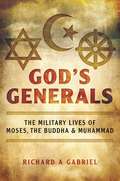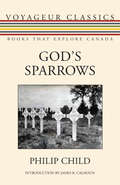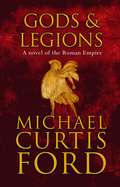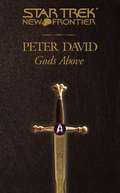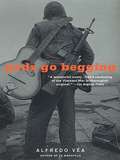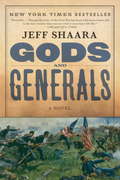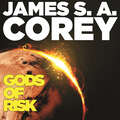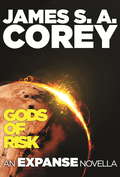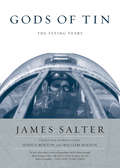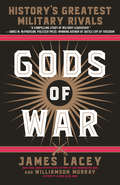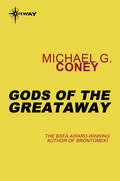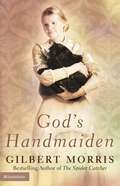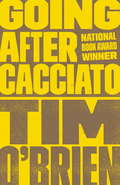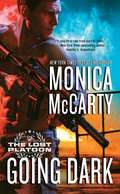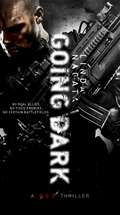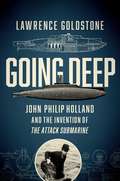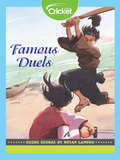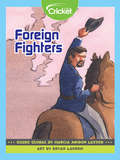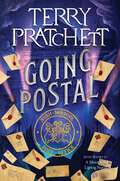- Table View
- List View
God's Generals: The Military Lives of Moses, the Buddha, and Muhammad
by Richard A. GabrielExamines how the military experience of three religious founders shaped their spiritual legacy.It is one of the more startling facts of military history that the founders of three of the four "great religions"-Judaism, Buddhism, and Islam-were also accomplished field generals with extensive experience in commanding men in battle. One of these, Muhammad, fought eight battles and was wounded twice, once almost fatally. Another, Siddhartha Gautama (later to become the Buddha), witnessed so much battlefield carnage that he suffered a psychological collapse. Moses had become so much a "god-intoxicated" personality that it is a reasonable suspicion that he, like the Buddha, was murdered.Indeed, had the experiences of these men in war not been so successful, it is quite possible that their achievements as religious leaders would never have occurred. For all three, war and religion were so closely intertwined in their personalities that it is difficult to discern where the influence of one ended and the other began.This book attempts to explore the military lives of Moses, the Buddha, and Muhammad, and the role their war experiences played in their religious lives.Skyhorse Publishing, as well as our Arcade imprint, are proud to publish a broad range of books for readers interested in history--books about World War II, the Third Reich, Hitler and his henchmen, the JFK assassination, conspiracies, the American Civil War, the American Revolution, gladiators, Vikings, ancient Rome, medieval times, the old West, and much more. While not every title we publish becomes a New York Times bestseller or a national bestseller, we are committed to books on subjects that are sometimes overlooked and to authors whose work might not otherwise find a home.
God's Shadow: Sultan Selim, His Ottoman Empire, And The Making Of The Modern World
by Alan Mikhail“A stunning work of global history. . . . Alan Mikhail offers a bold and thoroughly convincing new way to think about the origins of the modern world. . . . A tour de force.” —Greg Grandin Long neglected in world history, the Ottoman Empire was a hub of intellectual fervor, geopolitical power, and enlightened pluralistic rule. At the height of their authority in the sixteenth century, the Ottomans, with extraordinary military dominance and unparalleled monopolies over trade routes, controlled more territory and ruled over more people than any world power, forcing Europeans out of the Mediterranean and to the New World. Yet, despite its towering influence and centrality to the rise of our modern world, the Ottoman Empire’s history has for centuries been distorted, misrepresented, and even suppressed in the West. Now Alan Mikhail presents a vitally needed recasting of Ottoman history, retelling the story of the Ottoman conquest of the world through the dramatic biography of Sultan Selim I (1470–1520). Born to a concubine, and the fourth of his sultan father’s ten sons, Selim was never meant to inherit the throne. With personal charisma and military prowess—as well as the guidance of his remarkably gifted mother, Gülbahar—Selim claimed power over the empire in 1512 and, through ruthless ambition, nearly tripled the territory under Ottoman control, building a governing structure that lasted into the twentieth century. At the same time, Selim—known by his subjects as “God’s Shadow on Earth”—fostered religious diversity, welcoming Jews among other minority populations into the empire; encouraged learning and philosophy; and penned his own verse. Drawing on previously unexamined sources from multiple languages, and with original maps and stunning illustrations, Mikhail’s game-changing account “challenges readers to recalibrate their sense of history” (Leslie Peirce), adroitly using Selim’s life to upend prevailing shibboleths about Islamic history and jingoistic “rise of the West” theories that have held sway for decades. Whether recasting Christopher Columbus’s voyages to the “Americas” as a bumbling attempt to slay Muslims or showing how the Ottomans allowed slaves to become the elite of society while Christian states at the very same time waged the horrors of the transatlantic slave trade, God’s Shadow radically reshapes our understanding of the importance of Selim’s Ottoman Empire in the history of the modern world.
God's Sparrows
by Michael Gnarowski James R. Calhoun Philip ChildA new edition of Philip Child’s great Canadian novel of the First World War. A horrifying description of war, specifically embodied in the vain and inglorious futility of the First World War, God’s Sparrows is a novel rich in compassion and firm in its faith in the human spirit. Philip Child created a Canadian family saga, a modern pilgrim’s progress in which individuals surmount the corrosive effects of brutality, maintaining their ability to love and endure under the most agonizing circumstances. His book, first published in 1937, remains as a stirring testimony to that ability. It offers profound insight into the experience of the First World War, not just as a catastrophe affecting his characters but as a crucible in which the whole of this nation found itself tried.
God's Wolf: The Life Of The Most Notorious Of All Crusaders, Scourge Of Saladin
by Jeffrey Lee“[Jeffrey Lee] brings a blockbuster sensibility to this slice of the 12th century Levant.”—Dan Jones, Sunday Times (UK) In a 2010 terrorist plot, Al-Qaeda hid a bomb in a FedEx shipment addressed to a man who had been dead for 800 years. Born in twelfth-century France and bred for violence, Reynald de Chatillon was a young knight who joined the Second Crusade and rose through the ranks to become the preeminent figure in the crusader Kingdom of Jerusalem, chief foe of the Muslim leader Saladin, and one of the most reviled characters in Islamic history. In the West, Reynald has long been considered a minor player in the crusading saga, and is often dismissed as a bloodthirsty maniac who brought disaster on his fellow crusaders. However, by using contemporary documents and original research, Jeffrey Lee overturns this popular perception and questions other prejudices about the crusades that underlie modern misunderstandings of the Middle East. God’s Wolf shows how the crusader kingdom was brought down by a treacherous internal faction, rather than by Reynald’s belligerence. In fact, despite Reynald’s brutality, Lee argues that he was a strong military leader and an effective statesman, whose actions in the Middle East had a far-reaching impact that endures to this day. An epic saga set in the midst of a violent clash of civilizations, God’s Wolf is the fascinating story of an exceptional crusader and a provocative reinterpretation of the crusading era.
Gods & Legions: A Novel of the Roman Empire
by Michael Curtis FordRanging from the forbidding forests of ancient Gaul to the sweltering sands of Persia, Gods & Legions is a breathtaking historical re-creation of one of the most dangerous periods - and enduring mysteries - of all time. Perfect for fans of Simon Scarrow, Ben Kane, Conn Iggulden, Harry Sidebottom and S.J.A. Turney.354 AD. Julian, a young scholar in Athens, is the last survivor of a bloody political purge that killed his entire family. Unexpectedly summoned to the court of the Emperor Constantius, he fears the worst-only to find himself bearing the ring of Caesar of the Western Empire.Tested by bloody battle and the scepticism of the Roman legions, Julian proves to be a military genius, crushing the German tribes that have threatened Rome for generations. Soon after, defying his own emperor against overwhelming odds, he risks civil war and ultimately seizes the Empire for himself, becoming the most powerful man in the world while still only thirty.Now the dark side of his ambition emerges. Julian discards the Christianity of his boyhood and sets his sights on the greatest conquest of all-the Persian Empire. In Persia, however, his gods and his sanity desert him, and in one swift stroke, the course of history is altered forever.'Stirring and adventurous tragedy of the first rank, written with all the gusto of a master pulp stylist' - Kirkus Reviews______________________________REAL READERS LOVE GODS & LEGIONS:'I highly recommend this book' Goodreads member'A great book that puts you in the time when the Roman Empire was divided into the western and eastern empire' Goodreads member
Gods Above (Star Trek #13)
by Peter DavidCaptain Mackenzie Calhoun has often been accused of playing God, but he has never faced off against real gods -- until now. As Captain Kirk did before him, Calhoun has encountered beings of unnatural power and abilities verging on godhood, and who claim to be the very individuals who inspired the Greek, Roman, Norse, and, other pantheons from Earth culture. These beings say that all they want is our worship, and in return for it will provide us with a peaceful galaxy-wide paradise of perfect health and endless pleasure. When the Federation, in the person of Captain Calhoun and the crew of the U.S.S. Excalibur, refused their offer, the resulting battle left Morgan Primus dead and Lieutenant Mark McHenry, whose own powers over time and space had proved to be substantial, in a limbo beyond death. Now, with a wounded ship and an injured crew, Captain Calhoun, along with Captain Shelby and the crew of the Trident, must face these god-like beings once again, with the fate of galactic civilization at stake.
Gods Go Begging
by Alfredo Vea"Luminous... a beautiful book." - Carolyn See For Vietnam veteran Jesse Pasadoble, now a defense attorney living in San Francisco, the battle still rages: in his memories, in the gang wars erupting on Potrero Hill, and in the recent slaying of two women: one black, one Vietnamese. While seeking justice for the young man accused of this brutal double murder, Jesse must walk with the ghosts of men who died on another hill... men who were his comrades and friends in a war that crossed racial divides. Gods Go Begging is a new classic of Latino literature, a literary detective novel that moves seamlessly between the jungles of Vietnam and the streets of modern day San Francisco. Described as "John Steinbeck crossed with Gabriel García Márquez", Véa weaves a powerful and cathartic story of war and peace, guilt and innocence, suffering and love - and of one man's climb toward salvation.
Gods and Generals: A Novel of the Civil War (Civil War Trilogy #1)
by Jeff ShaaraBring back the pleasure of reading, readJeff Shaarain Large Print. All Random House Large Print Editions are published in a 16-point typeface. The story ofGods and Generalsbegins with Michael Shaara, author of the Pulitzer Prize-winning classicThe Killer Angels. A native of New Jersey, Michael Shaara grew to be an adventurous young man: over the years, he found work as a sailor, a paratrooper, a policeman, and an English professor at Florida State University. In 1952, his son Jeff was born in New Brunswick, New Jersey. Michael's interest in Gettysburg was prompted by some letters written by his great-grandfather, who had been wounded at the great battle while serving with the 4th Georgia Infantry. In 1966, he took his family on a vacation to the battlefield and found himself moved. In 1970, Michael Shaara returned to Gettysburg with his son Jeff. The pair crisscrossed the historic site, gathering detailed information for the father's novel-in-progress. In 1974, the novel was published with the titleThe Killer Angels. This gripping fictional account of the three bloody days at Gettysburg won Michael Shaara a Pulitzer Prize and a vast, appreciative audience. To date it has sold two million copies. When Michael Shaara died in 1988, his son Jeff began to manage his literary estate. It was a legacy he knew well, having helped his father create it. When director Ron Maxwell filmed the movieGettysburg, based onThe Killer Angels, he asked Jeff to serve as a consultant. Maxwell encouraged Shaara to continue the story his father began; inspired, Jeff planned an ambitious trilogy, withThe Killer Angelsas the centerpiece, following the war from its origins to its end. WithGods and Generals, Jeff Shaara gives fans ofThe Killer Angelseverything they could have asked--an epic, brilliantly written saga that brings the nation's greatest conflict to life.
Gods of Risk: An Expanse Novella (Expanse #17)
by James S. CoreyGods of Risk is a novella that expands the world of James S. A. Corey's New York Times bestselling Expanse series - now a Prime Original TV series.As tension between Mars and Earth mounts, and terrorism plagues the Martian city of Londres Nova, sixteen-year-old David Draper is fighting his own lonely war. A gifted chemist vying for a place at the university, David leads a secret life as a manufacturer for a ruthless drug dealer. When his friend Leelee goes missing, leaving signs of the dealer's involvement, David takes it upon himself to save her. But first he must shake his aunt Bobbie Draper, an ex-marine who has been set adrift in her own life after a mysterious series of events nobody is talking about.The Expanse series: Leviathan WakesCaliban's WarAbaddon's GateCibola BurnNemesis GamesBabylon's AshesPersepolis RisingTiamat's WrathPraise for the Expanse: 'The science fictional equivalent of A Song of Ice and Fire' NPR Books'As close as you'll get to a Hollywood blockbuster in book form' io9.com'Great characters, excellent dialogue, memorable fights' wired.com'High adventure equalling the best space opera has to offer, cutting-edge technology and a group of unforgettable characters . . . Perhaps one of the best tales the genre has yet to produce' Library Journal'This is the future the way it's supposed to be' Wall Street Journal'Tense and thrilling' SciFiNow
Gods of Risk: An Expanse Novella (Expanse #9)
by James S. CoreyGods of Risk is a novella that expands the world of James S. A. Corey's New York Times bestselling Expanse series - now a Prime Original TV series.As tension between Mars and Earth mounts, and terrorism plagues the Martian city of Londres Nova, sixteen-year-old David Draper is fighting his own lonely war. A gifted chemist vying for a place at the university, David leads a secret life as a manufacturer for a ruthless drug dealer. When his friend Leelee goes missing, leaving signs of the dealer's involvement, David takes it upon himself to save her. But first he must shake his aunt Bobbie Draper, an ex-marine who has been set adrift in her own life after a mysterious series of events nobody is talking about.The Expanse series: Leviathan WakesCaliban's WarAbaddon's GateCibola BurnNemesis GamesBabylon's AshesPersepolis RisingTiamat's WrathPraise for the Expanse: 'The science fictional equivalent of A Song of Ice and Fire' NPR Books'As close as you'll get to a Hollywood blockbuster in book form' io9.com'Great characters, excellent dialogue, memorable fights' wired.com'High adventure equalling the best space opera has to offer, cutting-edge technology and a group of unforgettable characters . . . Perhaps one of the best tales the genre has yet to produce' Library Journal'This is the future the way it's supposed to be' Wall Street Journal'Tense and thrilling' SciFiNow
Gods of Tin: The Flying Years
by James SalterA singular life often circles around a singular moment, an occasion when one's life in the world is defined forever and the emotional vocabulary set. For the extraordinary writer James Salter, this moment was contained in the fighter planes over Korea where, during his young manhood, he flew more than one hundred missions.James Salter is considered one of America's greatest prose stylists. The Arm of Flesh (later revised and retitled Cassada) and his first novel, The Hunters, are legendary in military circles for their descriptions of flying and aerial combat. A former Air Force pilot who flew F–86 fighters in Korea, Salter writes with matchless insight about the terror and exhilaration of the pilot's life.
Gods of War: History's Greatest Military Rivals
by Williamson Murray James LaceyHannibal vs. Scipio. Grant vs. Lee. Rommel vs. Patton. The greatest battles, commanders, and rivalries of all time come to life in this engrossing guide to the geniuses of military history. &“A compelling study of military leadership.&”—James M. McPherson, Pulitzer Prize–winning author of Battle Cry of Freedom Any meeting of genius may create sparks, but when military geniuses meet, their confrontations play out upon a vast panorama of states or civilizations at war, wielding the full destructive power of a mighty nation&’s armies. Gods of War is the first single-volume, in-depth examination of the most celebrated military rivalries of all time, and of the rare, world-changing battles in which these great commanders in history matched themselves against true equals. From Caesar and Pompey deciding the fate of the Roman Republic, to Grant and Lee battling for a year during the American Civil War, to Rommel and Montgomery and Patton meeting in battle after battle as Hitler strove for European domination, these match-ups and their corresponding strategies are among the most memorable in history. A thrilling look into both the generals&’ lives and their hardest-fought battles, Gods of War is also a thought-provoking analysis of the qualities that make a strong commander and a deep exploration of the historical context in which the contestants were required to wage war, all told with rousing narrative flair. And in a time when technology has made the potential costs of war even greater, it is a masterful look at how military strategy has evolved and what it will take for leaders to guide their nations to peace in the future.
Gods of the Greataway
by Michael G. ConeyMillennia ago Starquin visited the Solar System. Because he is huge - some say bigger than the Solar System itself - he could not set foot on Earth personally. yet events here were beginning to interest him, and he wanted to observe more closely.So he sent down extensions of himself, creatures fashioned after Earth's dominant life-form. In one of Earth's languages they became known as Dedos, or Fingers of Starquin. Disguised, they mingled with Mankind.We know this now, here at the end of Earth's time. The information is all held in Earth's great computer, the Rainbow. The Rainbow will endure as long as Earth exists, watching, listening, recording and thinking. I am an extension of the Rainbow, just as the Dedos are extensions of Starquin. My name is Alan-Blue-Cloud. It is possible you cannot see me but are aware of me only as a voice speaking to you from a desolate hillside, telling you tales from the Song of Earth. I can see you, the motley remains of the human race, however. You sit there with our clubs and you chew your roots, entranced and half-disbelieving as I sing the Song - and in our faces are signs of the work of your great geneticist, Mordecai N. Whirst. Catlike eyes here, broad muzzles there, all the genes of Earth's life, expertly blended, each having its purpose. Strong people, adapted people, people who survived.The story I will tell is about people who were not so strong. It is perhaps the most famous in the whole Song of Earth, and it tells of three simple human beings involved in a quest who unwittingly became involved in much greater events concerning the almighty Starquin himself. It is a story of heroism and love, and it ends in triumph - and it will remind the humans among you of the greatness that was once yours.
God’s Handmaiden
by Gilbert MorrisA historical and romantic adventure woven around the story of Florence Nightingale.Gervase Howard is in her mid-teens when her working-class mother dies and she must go to live with relatives in service to a wealthy, noble family, outside of London. While learning various jobs, she is drawn to the eldest son, Davis. Her fascination with him grows deeper, but more hopeless, since the two are separated not just by class, but also by Davis’s love for Roberta.When Davis announces his engagement, he asks Gervase to join them as Roberta’s maid. But instead Gervase becomes a companion to Florence Nightingale and accompanies her when the Crimean War breaks out and she is asked to create a corps of nurses. On the field, Gervase crosses paths with Davis, who has become disillusioned in his marriage and is drawn to her warmth and care. Both know, however, there is nothing more for them than friendship.Upon her return to England, Gervase receives word that Davis has been seriously injured in a fall and is asked to nurse him back to health. As he regains consciousness, he reveals shocking news that plunges them both into danger.
Goering: The Rise and Fall of the Notorious Nazi Leader
by Heinrich Fraenkel Roger ManvellIn Goering, Roger Manvell and Heinrich Fraenkel use first-hand testimonies and a variety of historical documents to tell the story of a monster lurking in Hitler's shadows. After rising through the ranks of the German army, Hermann Goering became Hitler's right hand man and was hand-picked to head the Luftwaffe, one of history's most feared fighting forces. As he rose in power, though, Goering became disillusioned and was eventually shunned from Hitler's inner circle. Alone at the end, he faced justice at the Nuremberg trials and was convicted of war crimes and crime against humanity. He committed suicide in prison before he could be hanged. Within these pages, Manvell and Fraenkel bring to life one of history's most complicated and hated characters.
Going After Cacciato: A Novel (Flamingo Ser.)
by Tim O'Brien"To call Going After Cacciato a novel about war is like calling Moby-Dick a novel about whales."So wrote The New York Times of Tim O'Brien's now classic novel of Vietnam. Winner of the 1979 National Book Award, Going After Cacciato captures the peculiar mixture of horror and hallucination that marked this strangest of wars.In a blend of reality and fantasy, this novel tells the story of a young soldier who one day lays down his rifle and sets off on a quixotic journey from the jungles of Indochina to the streets of Paris. In its memorable evocation of men both fleeing from and meeting the demands of battle, Going After Cacciato stands as much more than just a great war novel. Ultimately it's about the forces of fear and heroism that do battle in the hearts of us all. <P><P> Winner of the National Book Award
Going Dark (The Lost Platoon #1)
by Monica MccartyThe members of a top secret SEAL Team can’t keep their passion under wraps in this thrilling contemporary romantic suspense series from New York Times bestselling author Monica McCarty. Like Rome’s Lost Legion, a SEAL platoon goes on a mission and vanishes without a trace. After walking into a trap on a covert op in Russia, the men from top secret SEAL Team Nine are presumed dead. Not knowing whom they can trust, and with war hanging in the balance, the survivors must go dark and scatter around the globe. Marine ecologist Annie Henderson joins her new boyfriend on a trip to the Western Isles of Scotland to protest a hazardous offshore drilling venture. When she realizes that she may be swept up in something far more dangerous than she’d intended, there is only one man she can turn to. . . . She and the mysterious but sexy dive boat captain haven’t exactly gotten off to the best start, but something about his quiet confidence makes her think that he’s the kind of man she can depend on. Because he’s gruff and guarded, she can tell Dan Warren has secrets. But she could never imagine how high the stakes are for him to keep his cover, even as he risks everything to protect her. . . .
Going Dark (The Red Trilogy #3)
by Linda NagataIn the third book in The Red Trilogy, former Army Lt. James Shelley becomes a black ops sniper working for the Red--a suspected rogue artificial intelligence that is ripped from today's headlines.James Shelley has left his lover, Delphi, and his companion-in-arms, Jayne Vasquez, with a fortune acquired from a fallen oligarch. They believe him to be dead, and he doesn't try to set the record straight. His long-running question has been answered: There are other soldiers like him who have served the purposes of the Red--and he has accepted his place among them. As a soldier of the Red he pursues covert missions designed to nudge history away from existential threats--but that doesn't mean the world is growing more orderly. It's only in the froth of a "managed chaos" that human potential can grow and thrive. Shelley's missions eventually take him into orbit--and into conflict with those he loves--Delphi and Jaynie--who are determined to escape the influence of the Red.
Going Deep: John Philip Holland And The Invention Of The Attack Submarine
by Lawrence GoldstoneThe controversial history of the attack submarine—and the story of its colorful creator, John Philip Holland—that reveals how this imaginative invention changed the face of modern warfare. From Twenty Thousand Leagues Under the Sea to The Hunt for Red October, readers the world over have demonstrated an enduring fascination with travel under the sea. Yet the riveting story behind the invention of the submarine—an epic saga of genius, persistence, ruthlessness, and deceit—is almost completely unknown. Like Henry Ford and the Wright brothers, John Philip Holland was completely self-taught, a brilliant man raised in humble circumstances, earning his living as a schoolteacher and choirmaster. But all the while he was obsessed with creating a machine that could successfully cruise beneath the waves. His struggle to unlock the mystery behind controlled undersea navigation would take three decades, during which he endured skepticism, disappointment, and betrayal. But his indestructible belief in himself and his ideas led him to finally succeed where so many others had failed. Going Deep is a vivid chronicle of the fierce battles not only under the water, but also in the back rooms of Wall Street and the committee rooms of Congress. A rousing adventure—surrounded by an atmosphere of corruption and greed—at its heart this a story of bravery, passion, and the unbreakable determination to succeed against long odds.
Going Free: American POWs in WWII Philippines (A Vintage Short)
by Hampton SidesAn eBook short.From Hampton Sides's Ghost Soldiers, a gripping narrative of World War II POWs on the brink of freedom. The men of Cabanatuan had been held by the Japanese since the Bataan Death March, in increasingly dire circumstances. With the war turning in the Americans' favor, the POWs worried that their captors would murder them all in the frenzy of an all-out withdrawal. Then one day in early January, 1945, the prison guards simply left. For a brief moment the haggard survivors of Cabanatuan were given the keys to their prison, though swift death was promised to anyone who dared leave. The prisoners waited nervously, all while (unbeknownst to them) a daring raid was being planned which would result in their rescue or their end. This is Hampton Sides at his most riveting, a fitting tribute to these soldiers who would be prisoners no more.
Going Global: Famous Duels
by Marcia Amidon LustedDueling once was used as a way to settle disputes or to defend honor. Some are more well-known than others—explore three of them here!
Going Global: Foreign Fighters
by Marcia Amidon LustedLearn about how foreign soldiers were prized by the Union and Confederate armies because they had experience fighting in European wars.
Going Global?
by Katia Vlachos Mark A. Lorell Victoria A. Greenfield Julia F. Lowell Richard M. MooreThe increasing consolidation of the defense aerospace industry, brought about by post-Cold War reductions in defense authorizations, has led to the proliferation of cross-border relationships between U.S. and European firms. This report examines aerospace industry globalization trends with a view toward determining how the U.S. Air Force can best exploit such trends while minimizing their risks. It concludes that further research must be done to ascertain how the advantages of globalization, such as increased competition and interoperability, can best be achieved without compromising security concerns.
Going Home: A Novel (The Survivalist Series #1)
by A. AmericanBook 1 of The Survivalist Series If society collapsed, could you survive? When Morgan Carter's car breaks down 250 miles from his home, he figures his weekend plans are ruined. But things are about to get much, much worse: the country's power grid has collapsed. There is no electricity, no running water, no Internet, and no way to know when normalcy will be restored--if it ever will be. An avid survivalist, Morgan takes to the road with his prepper pack on his back. During the grueling trek from Tallahassee to his home in Lake County, chaos threatens his every step but Morgan is hell-bent on getting home to his wife and daughters--and he'll do whatever it takes to make that happen. Fans of James Wesley Rawles, William R. Forstchen's One Second After, and The End by G. Michael Hopf will revel in A. American's apocalyptic tale.
Going Postal: A Novel Of Discworld (Moist von Lipwig #1)
by Terry Pratchett“Pratchett’s books are almost always better than they have to be, and Going Postal is no exception, full of nimble wordplay, devious plotting and outrageous situations, but always grounded in an astute understanding of human nature.”—San Francisco ChronicleA splendid send-up of government bureaucracy, corruption, the postal system, and everything in between in this ingenious entry in Sir Terry Pratchett’s internationally bestselling Discworld series.By all rights, Arch-swindler Moist von Lipwig should be meeting his maker at the end of a noose. Instead, Lord Vetinari, supreme ruler of Ankh-Morpork, has made him the city’s Postmaster General. Death may be preferable to fixing the Postal Service—a creaky, outdated institution beset by eccentric employees, mountains of old, undelivered mail Moist swears is talking to him, and a dangerous secret order. To restore the postal service to its former glory, Moist accepts the help of the tough talking and very attractive activist Adora Belle Dearheart.But to succeed, Moist must overcome two formidable foes—new technology and the greedy chairman of a communication monopoly who will stop at nothing to delay Ankh-Morpork’s post for good . . .The Discworld novels can be read in any order, but Going Postal is the first book in the Moist von Lipwig series. The series, in order, includes:Going PostalMaking MoneyRaising Steam
